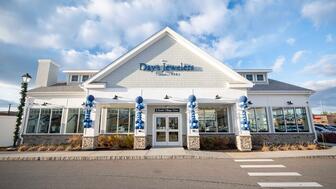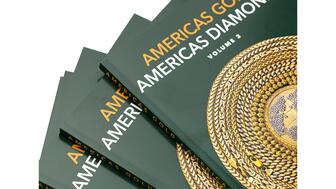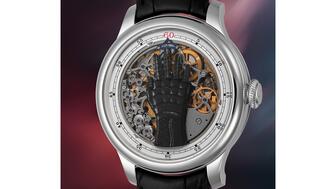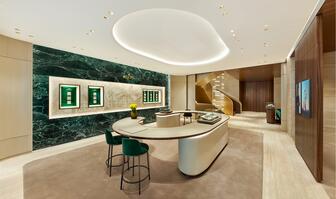5 Things to Know About … Rhodochrosite
Learn about one relatively new project bringing more material from a storied site.

There’s something about specimens that crystallize in perfect cubic shapes that is so alluring, especially when they’re in matrix. This is probably where my interest in rhodochrosite grew from.
In its purest (and best, in my opinion) form, the manganese carbonate is a vibrant red color, and the fine mineral specimens are stunning.
The rhodochrosite market has plenty of interest for faceted or polished goods and mineral specimens, though both are rare. With some new activity in the space, this interest is likely to continue.
Here are five things you should know about the mineral.
1. Its looks can take a few different forms.
Rhodochrosite gets its color from manganese, but because the mineral has a variable chemical composition, the manganese can be replaced in small amounts by iron, magnesium and/or calcium.
These substitutions alter the specific gravity, hardness, and color of the mineral.
In fact, its color can range from light pink to bright red, and can even become grayish, yellowish, or brownish as the chemical composition varies.
Additionally, the environment during rhodochrosite’s formation can have a major effect on the way it looks.
When it forms along mineral veins in pockets, rhodochrosite crystals can take shape.
It can also form as stalactites when water drips from manganese-rich rocks, creating banded material; that is often cut as slabs or used for ornamental objects, cabochons, beads, and more.
2. It’s found at a handful of sources, but supply of fine goods is low.
The list of sources for rhodochrosite doesn’t seem insignificant when you line them up, especially when compared to some other gemstones.
But the reality is that, like most colored gems, supply is limited.
“Rhodochrosite was the first stone in my cutting career where I realized you should buy things when they’re available and not when you need them. Because when you need them, they won’t be available,” gemstone cutter and wholesaler John Bradshaw said in a recent interview.
Rhodochrosite used for lapidary and mineral specimens has been found in Argentina, South Africa, Peru, Montana, Russia, China, Gabon, Mexico, and Japan, among others, according to several gemological and geological sources.
Argentina is a large source of the banded material, where stalagmites form in long-abandoned Incan silver mines, the International Gem Society said. (The mineral is often associated with silver deposits.)
The material from South Africa, meanwhile, is known for being rich in color but more of a darker hue, which some call blood red.
That material is “probably the oldest and most well-known … or was the most well-known,” Bradshaw said, noting there is virtually no production anymore; he sources South African rhodochrosite from old inventories.
Sweet Home started as a silver mine in the 1870s, at which time the rhodochrosite was just seen as waste rock, according to Steve Behling, the sales manager at Collector’s Edge Minerals.
The mine wasn’t very productive, failing to make a profit for the first few decades, according to the Gemmological Association of Great Britain, and also faced an onslaught of competition in the late 1800s as more and more mines opened.
Soon enough, though, those red crystals were recognized for their worth and started gaining value, becoming the mine’s sole focus.
Sweet Home produces some of the finest rhodochrosite in the world—vibrant, cherry red crystals—and helped it gain its status as the Colorado state mineral in 2002.
The mine has also been known to turn out some large pieces.
In 1992, it produced its largest yet, the Alma King—a rhodochrosite crystal measuring 14.25 centimeters on one side sitting on a quartz matrix more than 2 feet long, according to GIA’s Gems & Gemology.
The Alma King is currently in the collection of the Denver Museum of Natural History.
Modern production at the site has been handled by Bryan Lees and his two companies: Colorado Calumet Co. does the mining and Collector’s Edge Minerals markets and sells the mineral specimens. (The facetable rough is sent to Ohio-based Iteco Inc. for cutting.)
Active mining ceased at Sweet Home in 2004, but there’s been some activity nearby that should excite rhodochrosite lovers.
3. There’s new production at a storied source.
Lees initially leased the Sweet Home Mine but bought it outright in 1991. He operated the mine for more than a decade, pulling out collectable crystal specimens and facetable rough material.
In 2004, realizing they had reached the end of mining at that level of Mount Bross, Lees and his companies ceased operations at Sweet Home.
Between 1991-2004, Colorado Calumet/Collector’s Edge pulled out about $100 million dollars’ worth of mineral specimens in current dollar value, sales manager Behling said.
But Lees always wanted to go back, he added, knowing there were more red stones to be found in the mountain. So, he studied its geology and in 2016 received government approval to start mining again.
The new project is 200 feet above where they had been mining prior. Their first task was to drill and blast a 400-foot tunnel into the side of the mountain to get to the mineralized veins.
They started to find pockets in late 2018, Behling said, and mineral specimens started hitting the market that year.
Facetable rough took longer to find, and cut stones from the new project just started coming out last summer, Iteco’s Paul Cory confirmed.
The two working areas are not connected underground—just located on the same mining site—so they gave the new one a different name but retained Sweet Home for marketing reasons; it’s been dubbed the Detroit City Portal at the Sweet Home Mine.
So far, production hasn’t quite been at the level of Sweet Home, Behling said, but noted it can be scattershot anyway.
“I can tell you for a fact that even in the original mine, it sometimes would be six months to a year in between major pockets. You’d move a lot of rock and once in a while, nature would give you a gift where you had this beautiful pocket of crystals. It’s a very feast-or-famine kind of mining.”
When speaking to facetable material from Detroit City, Cory said Sweet Home produced more rough per season than the new working area.
Part of that does have to do with the mining company’s increased ability to get crystals out undamaged, meaning they will be kept as mineral specimens rather than being cut.
But he put it this way: “To give you a scale of the supply, probably all of [National Jeweler’s] readers could carry the entire gem rough supply in a single box from the vault to their car parked nearby.”
4. Rhodochrosite mineral specimens can go for much more than faceted material.
Mineral collectors love when the specimens feature a crystal in matrix, rather than isolated or broken fragments, Behling said.
These kinds of pieces are rare, and when they do find them, collectors gobble them up.
“You may have a 3-inch-by-3-inch piece of matrix with several crystals on it, and it’ll be $100,000 or it’ll be $150,000.”
5. But faceted material is still highly coveted.
Sources also rarely turn out transparent material that can be faceted, and these pieces, too, are in high demand from buyers.
Gemstone cutter and wholesaler Bradshaw said when he recently held a virtual Tucson event, he sold out of several stones, and rhodochrosite was one of them.
Iteco’s Cory said, “The demand far exceeds the supply, and the market grows every year. The demand is worldwide, focused primarily on Japan, India, and the U.S. market. As more people become aware of the beauty of faceted rhodochrosite, the market becomes even larger.”
But rhodochrosite is not only low in supply; it also contains a few gemological characteristics that present a challenge for faceting.
First, it has perfect cleavage in three directions, so cutters must make sure they don’t put a large facet parallel to a cleavage plane, Cory said, which makes it more difficult to polish.
It also has a hardness of only 3.5-4 on the Mohs scale, so the stone is best set in earrings or necklaces, pieces that tends to take less abuse than rings or bracelets.
Even with this extra care required, cutters definitely will roll the dice on rhodochrosite when given the chance.
“In previous years, I would never consider cutting melee rhodochrosite, but I do now,” Bradshaw said. “Because it sells.”
Cory said stones bigger than 3 carats have about doubled in price over the last five years, while those weighing more than 10 carats have risen even more, perhaps triple from when the original Sweet Home Mine project closed in 2004.
The Latest

Set in a Tiffany & Co. necklace, it sold for $4.2 million, the highest price and price per carat paid for a Paraíba tourmaline at auction.

The jeweler’s “Deep Freeze” display showcases its iconic jewelry designs frozen in a vintage icebox.

Take luxury gifting to new heights this holiday season with the jeweler’s showstopping 12-carat sphene ring.

How Jewelers of America’s 20 Under 40 are leading to ensure a brighter future for the jewelry industry.

This year's theme is “Unveiling the Depths of the Ocean.”


In its annual report, Pinterest noted an increase in searches for brooches, heirloom jewelry, and ‘80s luxury.

Starting Jan. 1, customers can request the service for opal, peridot, and demantoid garnet.

Roseco’s 704-page catalog showcases new lab-grown diamonds, findings, tools & more—available in print or interactive digital editions.

The 111-year-old retailer celebrated the opening of its new location in Salem, New Hampshire, which is its third store in the state.

The new catalog features its most popular chains as well as new styles.

The filmmaker’s personal F.P. Journe “FFC” prototype was the star of Phillips’ recent record-setting watch auction in New York.

The new location in the Design District pays homage to Miami’s Art Deco heritage and its connection to the ocean.

Inflations, tariffs, and politics—including the government shutdown—were among consumers’ top concerns last month.

“Longtime favorite” presenters, as well as first-time speakers, will lead talks and workshops at the annual event in Tucson next year.

Silas Smith of Meridian Metalworks won the challenge with his pendant that blends Australian and American landscapes.

The sale of the 31.68-carat, sunset-hued stone was part of Sotheby’s first series of events and auctions in Abu Dhabi.

Most customers who walk into your store this month have made up their minds. Your job is to validate their choice, Emmanuel Raheb writes.

The collection features characters and motifs from Ukrainian folklore, including an enchanted mirror and a magic egg.

MatrixGold 3.11, the newest version of the jewelry design program, offers more flexibility, precision, and creative control.

The pavilion will be part of the 2026 JA New York Spring show, scheduled for March 15 to 17.

Kadet, a 1994 National Jeweler Retailer Hall of Fame inductee, helped grow the family-owned retailer in the Chicago area and beyond.

Billed as the world’s smallest wearable, Lumia Health’s new smart earrings have a health tracker subtly embedded in the back.

Don’t let those with December birthdays feel blue. Help them celebrate their month with blue zircon, turquoise, and tanzanite.

The new pink sapphire version of the piece dances with its wearer in the brand’s “Icons After Dark” holiday campaign.

A choice that’s generated a lot of commentary, Pantone says “Cloud Dancer” marks a fresh start and encourages relaxation and creativity.

The manufacturer’s holiday campaign features a gift guide filled with trending designs and jewelry that can be personalized.

The man was charged with theft, accused of ingesting the necklace while in a jewelry store in Auckland, New Zealand.


































